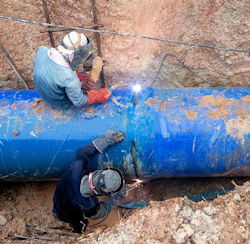How Cave-ins Occur
Undisturbed soil stays in place because opposing horizontal and vertical forces are evenly balanced.
When you create an excavation, you remove the soil that provides horizontal support. Soil will eventually move downward into the excavation. The longer the face (a side of the excavation) remains unsupported, the more likely it is to cave in.
Common Soil Problems
"Soil" and "earth" describe the naturally occurring materials uncovered on a excavation project. Soil may be loose or partially cemented, organic or inorganic. However, most soils can be referred to as a mixture or an accumulation of mineral grains that are not cemented together. An exception is hard rock, which remains firm after exposure to the elements.
Soil failure is defined as the collapse of part or all of an excavation wall. The most common soil failure is typically described as an unexpected settlement, or cave-in, of an excavation. Soil sliding is the most common factor leading to soil failure. It can occur for any number of reasons. Factors that increase the chances of soil failure are:
- excessive vibration - heavy equipment movement, earthquakes
- surface encumbrances - obstructions, broken water lines
- weather conditions - prolonged periods of rain
Real World Accident: December 2022 - Worker dies after being trapped by trench collapse in Buffalo Grove.
Knowledge Check Choose the best answer for the question.
1-2. In an excavation, what is the most common factor leading to soil failure?
You forgot to answer the question!

